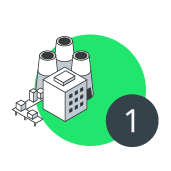The methodology in this standard is globally applicable, however numerical assumptions provided are based on UK locations and standard practices due to the availability and accessibility of data. Readers will therefore find that the methodology is more comprehensive and detailed for UK practitioners, however the standard also provides a framework for which WLCA can be effectively undertaken in all other locations and world regions. A full global methodology is not practical due to the variances in and availability of several key components, including specific product data, knowledge of individual countries’ approaches and assumptions to grid decarbonisation and overall end of life assumptions. To help overcome this, the standard provides comprehensive information of what “local” information should be used.
Measure whole-life carbon emissions, manage carbon budgets, reduce life cycle emissions and deliver a net-zero future for the built environment by adopting the RICS whole life carbon assessment (WLCA) standard, 2nd edition.
A world-leading and award-winning standard for consistent and accurate carbon measurement in the built environment, WLCA presents tangible opportunities for you in your work. The standard equips members and assessors with the right skills and knowledge for completing consistent and accurate carbon measurements. By giving visibility to embodied carbon, operational carbon and user carbon – a unique feature of the standard – a comprehensive and consistent approach can be used for decision making.
In full effect from 1 July 2024, RICS members need to follow the 2nd edition standard’s requirements when completing a whole life carbon assessment. This includes recording any deviations from the standard, as part of the assessment.
This dedicated hub has helpful resources to start your journey, from implementation guides and supporting documents to comprehensive training courses. You can also find a dedicated FAQ section, as well as adoptions and endorsements of the standard by global organisations.
“The second edition of whole life carbon assessment for the built environment encapsulates RICS' role as a global leader in the built environment and its duty to steer the industry towards decarbonisation. This second edition is a truly global standard for a global problem. I want to thank our members from every world region, our staff, partner specialists and the Department for Transport and Net Zero Waste Scotland for their hard work and crucial support, which made this a reality.”
Justin Young
RICS CEO
“The UK is a world leader in decarbonising transport. This new standard will help reduce the carbon footprint of not only transport projects, but also from projects across all buildings, as the UK works to grow its economy and reach its net zero goals.”

Jesse Norman MP
Decarbonisation Minister, Department for Transport
“This landmark publication will be a key driver for circularity as it provides a vital standard for assessing carbon over the whole life of a building. This whole life consideration prompts built environment professionals to confront the carbon impacts a building has before, during and after its use.”

Stephen Boyle
Built Environment Manager at Zero Waste Scotland
“The ICMS Coalition will support carbon measurement standards that are open, consistent, comprehensive, and align with and promote ICMS for life cycle costs and carbon emissions reporting. The first carbon measurement standard endorsed by the ICMS Coalition is the RICS Whole Life Carbon Assessment, Professional Standard, 2nd edition, which is a global approach to the measurement of carbon in the built environment. The coalition welcomes the adoption and alignment of ICMS 3rd edition within the new RICS standard. The ICMS Coalition welcomes other carbon measurement standard setters to contact us and be accessed for endorsement.”
ICMS Coalition
“CRREM initiative is supporting the RICS Whole Life Carbon Assessment, Professional Standard, 2nd edition. In our latest publication on “Embodied carbon of retrofits,” we are already referring to it. Global alignment, clear definitions and standards are key to ensure sufficient speed to achieve net zero by 2050 and avoid any form of greenwashing.”
CRREM
“Under our Sustainable Infrastructure Program, Transport for NSW is proudly working with our industry partners to deliver a world-leading program to decarbonise infrastructure across our $72.3 billion pipeline of work. Our adoption of the game changing RICS 2nd Edition, ICMS3 and PAS2080 standards demonstrate they translate internationally, providing certainty of process and clarity of purpose to all our partners, both in Australia and from around the globe.”

Camilla Drover
Deputy Secretary, Infrastructure and Place at Transport for NSW
Calculating and reporting carbon emissions over the lifecycle of a built asset
Through an assessment methodology based on six key principles:
- Comprehensive
- Data-driven
- Consistent
- Practical
- Aligned
- Integrated

Production
- Raw material extraction
- Manufacturing
- Transportation

Construction
- transportation
- assembly
- installation

Operation
- use
- maintenance
- repair
- renewal

End of life
- deconstruction
- waste processing
- disposal

Beyond asset life
potential for:
- reuse
- recycling
- energy recovery
Contact us
To find out more about the standard or for support in embedding it within your organisation, please contact our experts at: knowledge@rics.org
Explore the Whole life carbon assessment standard
Now available in interactive format on isurv, making it easier than ever to consistently integrate carbon assessments into your projects.
Explore now for only £79 for your first month.

For a whole life carbon assessment to be compliant with this standard, all mandatory requirements must be met whether the assessor is an RICS member or not. A certificate of compliance, as per the WLCA standard, should be produced to provide evidence that the methodology has been applied.
The WLCA went into full effect on 1 July 2024, nine months after publication. However, RICS will not regulate against the assessments produced or verify the actual results delivered. Instead, we require that when a WLCA is undertaken by RICS members, it is mandatory to be done in accordance with our professional standard, unless clear departures from it are identified. Further, RICS members are always required to ensure their professional obligations, in accordance with the RICS Rules of Conduct.
The WLCA standard provides the detailed methodology to enable consistent measurement and quantification of whole life carbon emissions, inclusive of all embodied and operational carbon throughout the whole life cycle of the asset, from initial design to end of life.
Included in this methodology is the International Cost Management Standard 3rd Edition (ICMS 3), a high-level reporting classification framework for both cost (capital and life cycle) and carbon of all built environment assets, globally.
The Built Environment Carbon Database (BECD) - currently only available in the UK - will be the repository where the WLCA data is submitted and stored for industry benchmarking and utilisation.
The UK Net Zero Carbon Building Standard (NZCBS), collaboratively developed by a cross-industry group, will set the targets and limits for building assets to be officially recognised as net-zero in line with the required scientific pathways. The measurement of carbon emissions to meet the NZCBS will be in accordance with RICS WLCA.
The International Building Operation Standard (IBOS), launched in 2022, is also an important part of visualising whole life carbon, specifically how carbon is measured while a building is in use, and how this can be reduced, to not only decrease carbon footprint, but to improve the environment of the building for the people who use them.
The 2nd edition of this professional standard is a significant expansion of the first, published in 2017. The most substantial changes are as follows:
- The 2nd edition aligns with the International Cost Management Standards (ICMS) 3rd Edition and the Built Environment Carbon Database (BECD) to provide a consistent output of cost and carbon reporting and benchmarking, for both new builds and existing assets. It also incorporates other professional guidance around embodied carbon measurement, for example from other professional bodies such as Chartered Institution of Building Services Engineers (CIBSE), Institute of Structural Engineers (IStructE) and the Centre for Window & Cladding Technology (CWCT).
- It sets a standard approach for assessing whole life carbon across the entire asset life cycle, particularly for benchmarking and early-stage advice, and now extends to both buildings and infrastructure, to enable WLCA to be undertaken across all sectors and asset types. Its better integration with existing software tools will make it easier to be used by SMEs, which make up approximately 80% of RICS members.
- The 2nd edition incorporates latest industry-agreed definitions for carbon terminology, to enable a clear understanding and approach and standardises the approach to assessing risk in terms of carbon assessment reporting.
- It addresses uncertainty in WLCA reporting by introducing the mandatory requirement to calculate and report a contingency allowance, which will vary dependent upon the stage at which the WLCA is produced, and the quality of the data being used.
- From a technical perspective the 2nd edition now includes greater detail of carbon data sources and conversion factors, explains the differences between manufacturer specific data, sector average data and generic data and provides additional guidance on grid and material decarbonisation, carbon sequestration and biogenic carbon. Guidance on retrofit and alignment with the circular economy will enable professionals to work to the most up-to-date standards.
The changes in the version 3 of the WLCA standard, 2nd edition, are minor and mostly editorial in nature. They have been made to add clarity and correct some issues that were identified following queries from users since the original publication. A version of the document that shows these specific changes can be requested by emailing knowledge@rics.org.
Funding support has come from the UK Department for Transport and from Zero Waste Scotland, a not-for-profit environmental organisation, funded by the Scottish Government and European Regional Development Fund. The funding has gone toward compensating the technical authors and experts who have given their skills, knowledge and expertise to develop this professional standard.
The WLCA standard provides clear guidance on carbon reduction and mitigation. It aligns with national and regional carbon budgets and benchmarks to limit whole life, embodied or operational carbon values.
In the UK, the Built Environment Carbon Database (BECD) will provide a range of carbon benchmarks at both an asset/entity and a material/product specific level. The UK Net Zero Carbon Buildings Standard (NZCBS) will determine the targets and limits for building assets to be officially recognised as net-zero in line with the required scientific pathways.
Yes, these products are currently under development by RICS and will be made available for RICS members as soon as possible.
As part of the development of WLCA 2nd edition, tool providers have been kept informed of the changes, updates and additions made from the 2017 edition. In order for these software tools to be compliant with the updated WLCA standard, they will need to make the required changes once the WLCA Standard takes effect, nine months after publication.

















